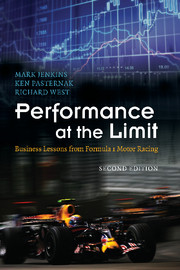Book contents
- Frontmatter
- Contents
- List of figures
- List of tables
- List of plates
- Acknowledgements
- Note on the reference system
- The Grand Prix experience
- 1 Introduction
- 2 Why Formula 1 motor racing?
- 3 The performance framework
- 4 The war for talent
- 5 Winning through teamwork
- 6 Capability through partnerships
- 7 The high-performance organisation
- 8 Integrating
- 9 Innovating
- 10 Transforming
- 11 Achieving and sustaining performance
- 12 Twelve business lessons from Formula 1 motor racing
- Appendix A Grand Prix Champions 1950–2008
- Appendix B Grand Prix Graveyard 1950–2008
- Appendix C Interview respondents
- References
- Index
- Plate section 1
- Plate section 2
3 - The performance framework
Published online by Cambridge University Press: 05 August 2013
- Frontmatter
- Contents
- List of figures
- List of tables
- List of plates
- Acknowledgements
- Note on the reference system
- The Grand Prix experience
- 1 Introduction
- 2 Why Formula 1 motor racing?
- 3 The performance framework
- 4 The war for talent
- 5 Winning through teamwork
- 6 Capability through partnerships
- 7 The high-performance organisation
- 8 Integrating
- 9 Innovating
- 10 Transforming
- 11 Achieving and sustaining performance
- 12 Twelve business lessons from Formula 1 motor racing
- Appendix A Grand Prix Champions 1950–2008
- Appendix B Grand Prix Graveyard 1950–2008
- Appendix C Interview respondents
- References
- Index
- Plate section 1
- Plate section 2
Summary
A Formula 1 team is a highly complex system. It combines many different resources such as human capital, technology, marketing and finance to achieve a performance outcome, hopefully superior to those of its competitors. It is a critical balance between maximising the potential of individual areas and optimising the overall performance to ensure that the integrated effect exceeds the sum of the parts. For many watching the Formula 1 spectacle it is all down to the skill of the driver. In our study we conclude that the driver is an important ingredient, both from the point of view of driving skill and also in influencing the motivation and dynamics of the team. But a driver can never succeed without the support of the organisation and its technology behind him. One only needs to look at situations where the winners of the Formula 1 World Drivers’ Championship have moved to other teams following their point of success to illustrate this effect. An example of this is provided in Figure 5.
In 1995, 1996 and 1997 three different drivers won the Drivers’ World Championship. Each of these drivers moved to a new team shortly following their Championship success and the subsequent fortunes of each were very different. In 1996 Damon Hill won the Drivers’ World Championship but left Williams to join Arrows in 1997, and then in 1998 moved to Jordan, eventually retiring at the end of 1999. Also driving for Williams, Jacques Villeneuve won the title in 1997; he stayed with the team during 1998, but then left to help set up the new British American Racing team (BAR) of which his manager, Craig Pollock, was Managing Director and a major shareholder. However, he was unable to repeat his earlier success and left BAR, retiring from Formula 1 at the end of 2003.
- Type
- Chapter
- Information
- Performance at the LimitBusiness Lessons from Formula 1 Motor Racing, pp. 29 - 38Publisher: Cambridge University PressPrint publication year: 2009



